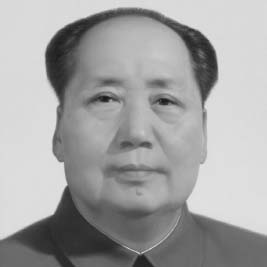Confucianism, the Literati, and Chinese Imperial TraditionsHistory and Sources |
How would you sum up the history of Confucianism? |
During the first couple of centuries after the time of Confucius, two major thinkers developed the beginnings of what we now call Confucianism. Mencius, or Meng Zi (371—289 B.C.E.), and Xun Zi (d. 215 B.C.E.) codified the teachings of the Master into the foundations of a political philosophy. Emperor Qin Shi Huang Di (221—210 B.C.E.), displeased with the emerging movement, tried to suppress it by burning all the Confucian texts. Before that emperor died, in 210 B.C.E., he had succeeded in transforming feudal China into a centralized bureaucracy, but Confucianism survived. Under the new Han dynasty (206 B.C.E.—220 C.E.), the state espoused Confucianism as its core ideology. Confucianism took institutional shape as a system for training the empire’s bureaucrats and officials, thereby strengthening the cultural elite known as the Literati.
For the next several centuries, Confucianism’s prestige dwindled as Buddhism’s star rose with increasing imperial patronage. During the Southern and Northern (265—581 C.E.), Sui (581—618), and Tang dynasties (618—906), Confucian ritual and Literati authority held on, criticizing Buddhism as an insidious import and enjoying sporadic periods of notoriety. Confucianism returned to prominence during the Song dynasty (960—1279) as a result of the Neo-Confucian revival. Scholars finalized the Canon of the Five Classics and Four Books, plus several subsidiary works. Official Neo-Confucian philosophies drifted away from traditional beliefs in a transcendent divine Heaven, emphasizing ethics and social responsibility. But a cult centered around Confucius survived. During the last of the Chinese dynasties, the Qing or Manchu (1644—1911), a generally strong Literati class continued to promote an increasingly static and dogmatic form of Confucian “orthodoxy.” The last emperor fell with the arrival of Sun Yat Sen’s new Republic and the Literati became functionally obsolete. Still, the leaders of the Republic held Confucius up as the epitome of Chinese culture. When Mao Zedong’s Communist movement began its rise in the 1930s, the Chairman declared himself fed up with Confucius and the old ways. In response, the Republican-Nationalist movement insisted that Confucianism represented all genuinely Chinese values. As the Nationalists fled the mainland and established themselves in Taiwan under Zhang Gai Shek in 1949, overt acknowledgment of Confucian tradition went with them.
| 2637 B.C.E. | Reckoning of Chinese lunar calendar of twelve months of twenty-nine or thirty days. | |
| 1994-1525 B.C.E. | Xia dynasty instituts the principle of hereditary succession. | |
| 1525-1028 B.C.E. | Shang dynasty overthrows the last Xia tyrant. | |
| 1028-222 B.C.E. | Zhou dynasty: Yi Jing, (Classic of Change), manual of divination. | |
| c. 800-600 B.C.E. | Shu Jing (Classic of History). | |
| 722-481 B.C.E. | Chun Qiu (Annals of Spring and Autumn). | |
| 551-479 B.C.E. | Lifetime of Kong Zi (Confucius). | |
| 400 B.C.E. | Confucius’ sayings edited. | |
| c. 372-289 B.C.E. | Meng Zi (or Mencius) and Xun Zi codified the teachings of Confucius into the foundations of a political philosophy. | |
| 221-210 B.C.E. | Emperor Qin Shi Huang Di tries to suppress Confucian texts, and transforms feudal China into centralized bureaucracy. | |
| 1 C.E. | Emperor Ping proclaims Confucius the “Exalted Mt. Ni Duke of the Highest Perfection.” | |
| c. 100 C.E. | Li Ji (Classic of Rites). | |
| c. 140-187 C.E. | Emperor Wu Di of Han dynasty makes Confucian system his official ideology. | |
| 195 C.E. | Early Imperial sacrifice at Confucius’ tomb. | |
| c. 206-221 C.E. | Han dynasty; Confucianism official state philosophy. | |
| 220-280 C.E. | Three Kingdoms period: Wei (220-266); Shu Han (221-263); Wu (222-280). | |
| c. 400 C.E. | Confucianism is introduced to Japan from Korea. | |
| 710-784 C.E. | Confucianism introduced to Japan in first permanent Japanese capital at Nara. | |
| 918-1392 C.E. | Confucianism important during Koryo dynasty in Korea. | |
| c. 960-1279 C.E. | Song dynasty; Neo-Confucian revival; Canon of the Five Classics and Four Books finalized by scholars. | |
| 1033-1107 C.E. | Cheng Yi, his brother Cheng Hao (1032-1085), and Zhu Xi (1130-1200), establish “Cheng Zhu School,” the School of Principle (li xue). | |
| 1392-1910 C.E. | During Yi dynasty, Korean Confucianism reaches its zenith. | |
| 1403-1424 C.E. | Yong Le, third emperor of Ming dynasty (1368-1644), founds the Forbidden City in Beijing. | |
| 1472-1529 C.E. | Life of Wang Yang Ming, leader of School of Mind (xin xie). | |
| 1516-1555 C.E. | Yang Jishang, Confucian Literati; dies as a martyr. | |
| 1530 C.E. | CIT hierarchical structure is replaced with titles. | |
| 1552-1610 C.E. | Matteo Ricci, Jesuit missionary to China. | |
| 1600-1868 C.E. | Confucianism gains influence in the Japanese Imperial government during Tokugawa period. | |
| 1622-1685 C.E. | Yamaga Soko, Japanese Confucian scholar and military theorist, originator of the way of the warrior, bushi-do. | |
| 1852-1932 C.E. | Liao Ping, who considers himself Confucius’ prophet. | |
| 1868-1945 C.E. | Confucians play important role in the Japanese Meiji Reform, with restoration of the emperor’s divine status. | |
| 1911 C.E. | Foundation of Chinese Republic; Confucius and sages held in the highest reverence. | |
| 1912 C.E. | Abdication of the last Chinese emperor. | |
| 1948 C.E. | Maoist Revolution; destruction of Confucian institutions. | |
| 1949 C.E. | The Republican Nationalist movement (origin of Taiwanese government) insists that Confucianism represents all genuine Chinese values. |

Chinese Communist leader Mao Zedong tried to eliminate Confucianism. (Hung Chung Chih / Shutterstock.com.)
